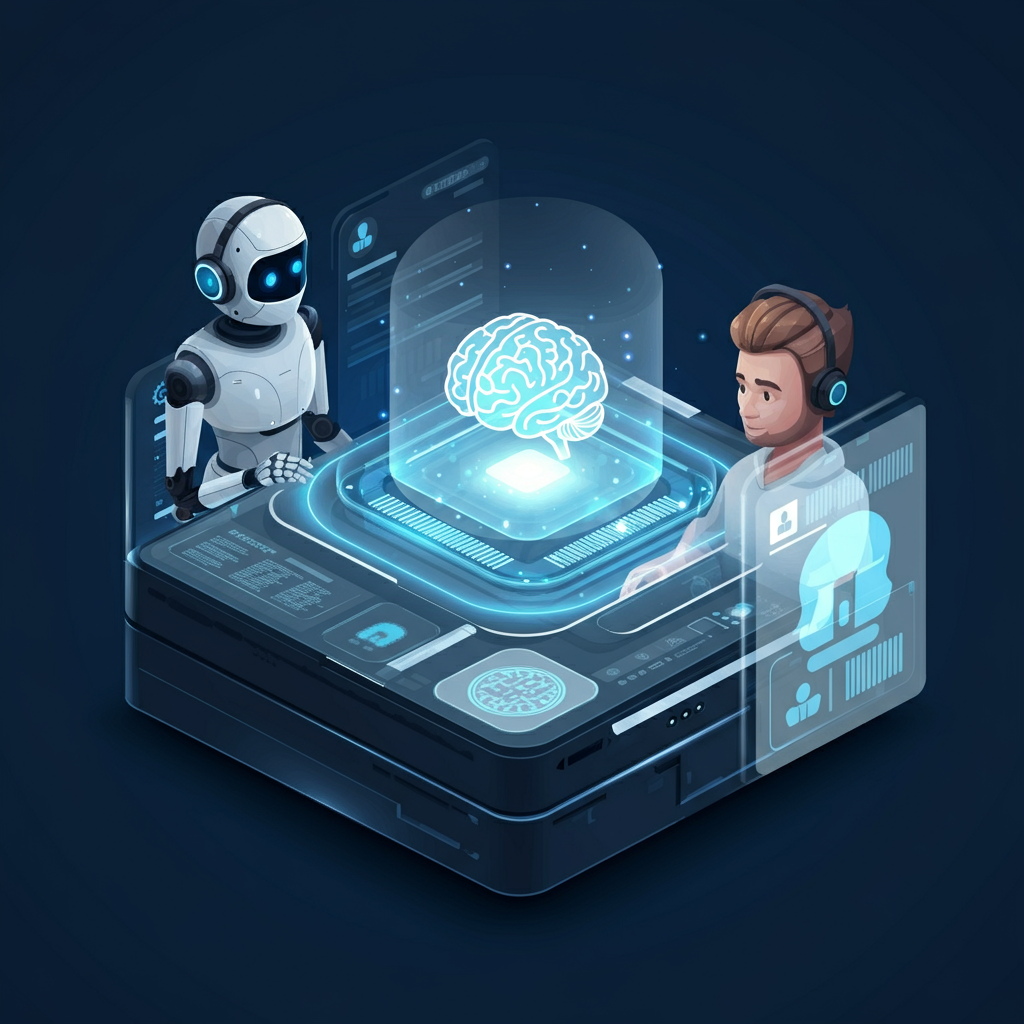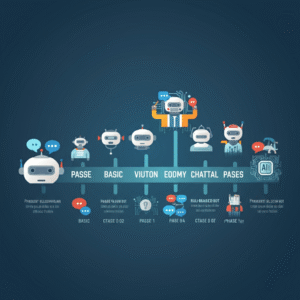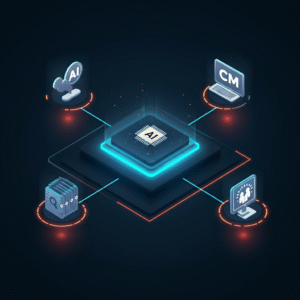
Introduction
Customer support is no longer confined to long hold times and generic email replies. A technological shift is underway, powered by generative AI. This technology is reshaping how businesses interact with their customers, offering instant, intelligent, and deeply personal assistance. From sophisticated chatbots that understand context to automated responses that feel human, generative AI is setting a new standard for customer service. This guide explores the transformative power of generative AI for customer support, detailing how it can enhance efficiency, boost satisfaction, and drive business growth.

What Is Generative AI in Customer Support?
Generative AI refers to a category of artificial intelligence systems capable of creating new and original content, such as text, images, or code. In the context of customer service, it means these systems can generate human-like, contextually relevant responses to customer inquiries. Unlike traditional AI, which often relies on pre-programmed scripts, generative AI can understand the nuances of a conversation, analyze customer history, and craft unique solutions in real time.
The core technology behind this revolution is the large language model (LLM), which is trained on vast datasets of text and code. This training allows the AI to recognize patterns, comprehend intent, and produce coherent and helpful dialogue. When a customer asks a question, the AI doesn’t just search a knowledge base for a matching keyword; it understands the query, processes the available information, and generates a tailored answer. This makes the application of generative AI for customer support a powerful tool for automating responses, personalizing interactions, and even predicting customer needs before they arise.
Key applications in customer service include:
- Automated Response Generation: Instantly creating replies for emails, chats, and social media messages.
- Intelligent Chatbots: Powering conversational agents that can handle complex queries.
- Personalized Recommendations: Suggesting products or solutions based on a customer’s profile and interaction history.
- Content Creation: Automatically generating help articles, FAQs, and training materials for support agents.
By leveraging these capabilities, businesses can provide a level of service that is both highly efficient and deeply personal, transforming a traditional cost center into a powerful engine for customer loyalty.
The Evolution of Chatbots
The journey of the chatbot from a simple, often frustrating tool to a sophisticated conversational partner is a testament to the rapid advancements in AI. Understanding this evolution helps clarify why the latest generation of chatbots represents such a significant leap forward for customer service.

Rule-Based Bots: The Starting Point
The earliest chatbots were rule-based. They operated on a simple “if-then” logic, following predefined conversational flows. These bots could only respond to specific keywords or phrases that developers had programmed into their system. If a customer’s query deviated even slightly from the script, the bot would typically respond with a frustrating “I don’t understand.” While useful for answering the most basic and common questions, their rigidity and lack of contextual understanding limited their effectiveness and often led to poor user experiences.
AI-Powered Chatbots: A Smarter Approach
The next stage brought AI-powered chatbots, which utilized technologies like natural language processing (NLP) and machine learning (ML). These bots could understand user intent and context, allowing for more flexible and natural conversations. They could recognize synonyms, handle typos, and learn from past interactions to improve their responses over time. This was a major improvement, as these chatbots could handle a wider range of queries without needing to escalate to a human agent immediately. However, their responses were still largely drawn from a predefined set of answers, even if they were better at finding the right one.
Generative Chatbots: The New Frontier
Today, we are in the era of generative chatbots. Powered by advanced LLMs like those behind ChatGPT, these bots can create new, dynamic, and personalized responses in real time. They don’t just pull from a knowledge base; they synthesize information to have truly conversational interactions. This capability is a game-changer for generative AI for customer support.
For example, a generative chatbot can:
- Maintain the context of a long, multi-turn conversation.
- Adjust its tone based on the customer’s sentiment.
- Summarize previous interactions to provide a seamless experience.
- Generate creative solutions to novel problems.
Companies like Intercom and Zendesk are already integrating this technology into their platforms, offering tools that do more than just answer questions—they engage, empathize, and solve problems in a way that feels remarkably human. This evolution has turned chatbots from a simple deflection tool into a core component of a modern customer support strategy.
Benefits of Using Generative AI for Customer Support
Integrating generative AI for customer support is not just about keeping up with technological trends; it’s a strategic move that delivers tangible benefits across the business. By automating and enhancing customer interactions, AI helps companies improve service quality, reduce operational costs, and build stronger customer relationships.

24/7 Availability and Instantaneous Responses
Customer expectations have shifted. They now demand support on their own terms, at any time of day or night. Generative AI-powered chatbots and virtual assistants are always on, providing instant answers to common questions and resolving issues without making customers wait. This round-the-clock availability ensures that help is always just a click or a message away, significantly improving customer satisfaction and reducing frustration associated with long wait times.
Significant Cost Efficiency
Human-led customer support can be expensive, requiring significant investment in staffing, training, and infrastructure. Generative AI automates a large volume of routine and repetitive inquiries, freeing up human agents to focus on more complex, high-value interactions. This automation leads to substantial cost savings. For instance, UK energy supplier Octopus Energy reported that its generative AI bot handles the workload of 250 human agents, demonstrating the immense potential for efficiency gains.
Enhanced Personalization at Scale
Personalization is a key differentiator in a crowded market. Generative AI excels at delivering tailored experiences by analyzing customer data, including past purchases, browsing history, and previous support interactions. It can use this information to provide personalized recommendations, address customers by name, and reference their history in a way that makes the interaction feel unique and valued. This level of personalization, delivered consistently to thousands of customers simultaneously, helps build strong brand loyalty.
Unprecedented Scalability
During peak seasons, product launches, or unexpected outages, customer inquiry volumes can skyrocket. Scaling a human support team to meet this demand is challenging and costly. Generative AI systems can handle thousands of conversations at once without any decline in performance. This scalability ensures that service quality remains high even during periods of intense demand, allowing businesses to grow without being constrained by their support capacity.
Improved Agent Productivity and Satisfaction
Far from replacing human agents, generative AI for customer support acts as a powerful co-pilot. It can handle Tier 1 queries, gather initial information from customers, and provide real-time assistance to human agents by suggesting responses or pulling relevant data. This support allows agents to resolve issues faster and with greater accuracy. By removing the burden of repetitive tasks, it also reduces agent burnout and allows them to focus on more engaging and fulfilling work, which boosts morale and retention.
Personalization: The Secret to Better Support
In an era of endless choice, a generic customer experience is a forgotten one. Personalization is no longer a luxury; it’s a core expectation. This is where generative AI for customer support truly shines, moving beyond simple automation to create interactions that are deeply relevant and tailored to each individual customer.

Generative AI achieves this by connecting and analyzing vast amounts of customer data in real time. It can access a customer’s entire history with your brand—past purchases, support tickets, browsing behavior, and even feedback from previous interactions. This holistic view allows the AI to understand not just the immediate question, but the person behind it.
Here’s how generative AI uses this data to deliver hyper-personalized support:
- Tailored Responses Based on Customer History: Instead of a generic “How can I help you?”, the AI can initiate a conversation with specific context. For example: “Hi David, I see your recent order for the X-15 drone is out for delivery. Are you contacting us about that today?” This immediately shows the customer you know who they are and anticipates their needs.
- Proactive Product and Solution Recommendations: By understanding a customer’s preferences and past behavior, the AI can suggest products or solutions they are likely to find valuable. If a customer frequently buys hiking gear, the AI can alert them to a new line of waterproof boots or offer a discount on a related accessory.
- Adaptive Tone and Language: AI can perform sentiment analysis on a customer’s messages to gauge their emotional state. If a customer seems frustrated, the AI can adopt a more empathetic and reassuring tone. If they are tech-savvy, it can use more technical language. This adaptability makes the interaction feel more natural and human.
- Predictive Support: The ultimate form of personalization is anticipating needs before the customer even has to ask. By analyzing behavioral patterns, generative AI can identify potential issues. For instance, if a user is repeatedly visiting a complex settings page in a software application, the AI could proactively pop up with a message: “It looks like you’re trying to configure advanced settings. Would you like to see a quick tutorial?”
This ability to personalize every touchpoint transforms customer support from a reactive function to a proactive, value-adding experience. It fosters a sense of being understood and valued, which is the foundation of lasting customer loyalty.
Integrating Generative AI with Your Current Systems
The power of generative AI for customer support is fully unlocked when it works in harmony with your existing technology stack. A standalone AI tool has limited context, but one that is deeply integrated with your core business systems can access the real-time data needed to provide accurate, personalized, and effective support.

Successful integration ensures a seamless flow of information between the AI and the platforms that house your customer data. This creates a unified ecosystem where your AI is always up-to-date and fully informed.
Key systems to integrate with your generative AI include:
- Customer Relationship Management (CRM) Platforms: Integrating with your CRM (like Salesforce, HubSpot, or Zoho) is crucial. This allows the AI to access a complete customer profile, including contact details, purchase history, past interactions, and any notes left by human agents. When a customer contacts you, the AI instantly knows who they are and their entire history with your company.
- Helpdesk Software: Connecting the AI to your helpdesk system (such as Zendesk, Freshdesk, or Intercom) enables it to create, update, and manage support tickets automatically. It can also analyze past tickets to identify trends and improve its knowledge base. This integration ensures that all interactions, whether handled by AI or a human, are logged in one central place.
- E-commerce Systems: For retail businesses, integration with platforms like Shopify, WooCommerce, or Magento is essential. This connection allows the AI to handle order-related queries with precision. It can check order statuses, process returns, answer questions about product availability, and even assist with checkout issues by accessing live inventory and order data.
- Messaging and Communication Channels: To provide a true omnichannel experience, your AI must be present where your customers are. This means integrating it with website chat widgets, mobile apps, social media messaging platforms (like Facebook Messenger), and even SMS and WhatsApp. An API-first approach ensures that your AI can be deployed consistently across all these channels.
By creating this interconnected web of systems, you empower your AI to do more than just answer questions. It becomes a central intelligence hub that not only serves customers but also enriches your other business systems with valuable data from every interaction.
The Power of Human + AI Collaboration
The rise of generative AI for customer support does not signal the end of the human agent. Instead, it marks the beginning of a new, more powerful partnership: the hybrid support model. In this model, AI and humans work together, each playing to their strengths to deliver a service that is faster, smarter, and more empathetic than either could achieve alone. This collaborative approach, often called “human-in-the-loop,” is the key to maximizing the value of your AI investment.

The synergy between AI and human agents is built on a simple division of labor:
- AI Handles the Repetitive, Humans Handle the Complex: AI is perfectly suited for managing high volumes of routine inquiries. It can instantly answer questions about order status, password resets, and product features. This frees up human agents from the monotonous tasks that lead to burnout and allows them to dedicate their time and expertise to issues that require empathy, critical thinking, and complex problem-solving.
- AI as an Agent’s Co-Pilot: Generative AI can serve as a powerful real-time assistant for human agents. During a live chat or call, the AI can listen to the conversation, understand the context, and provide the agent with relevant information from the knowledge base, suggest next steps, or even draft entire responses for the agent to review and send. This “agent assist” functionality dramatically speeds up resolution times and ensures consistency and accuracy.
- Seamless Escalation: Not every issue can or should be handled by AI. The best hybrid systems are designed for smooth, context-aware handoffs. When an AI determines that a customer is highly frustrated or that the issue is beyond its capabilities, it can seamlessly escalate the conversation to a human agent. Crucially, it passes along a complete summary of the interaction so far, so the customer doesn’t have to repeat themselves.
- AI for Training and Quality Assurance: Generative AI can analyze thousands of past support interactions to identify best practices and common pitfalls. This data can be used to create highly effective training materials for new agents. It can also monitor live interactions for quality control, flagging conversations that may require a manager’s attention and providing agents with real-time feedback.
This collaborative model creates a virtuous cycle. Agents become more effective and satisfied in their roles, while customers receive faster, more accurate service. The future of customer support isn’t about choosing between humans and AI; it’s about leveraging the strengths of both.
Training and Fine-Tuning Your AI
Implementing generative AI for customer support is not a “set it and forget it” process. Out of the box, a generic AI model has broad knowledge but lacks specific understanding of your business, products, and brand voice. To transform it into a truly effective support tool, you must train and fine-tune it with your own data. This process is what teaches the AI to speak your language and act as a true extension of your brand.
Training ensures your AI provides responses that are not only accurate but also consistent and on-brand. Here’s how to approach it:
- Feed It Your Knowledge: The first step is to provide the AI with a comprehensive library of your company’s information. This includes uploading your entire knowledge base, FAQs, help articles, product manuals, and even past support tickets (after anonymizing sensitive data). The AI will ingest this information to build a deep understanding of your products, policies, and common customer issues.
- Define Your Brand Voice and Tone: Every brand has a unique personality. Are you formal and professional, or friendly and casual? You can instruct the AI on the specific tone and style to use in its interactions. This is done through “prompting,” where you give the AI clear guidelines, such as “Always respond in a helpful and empathetic tone. Use simple language and avoid technical jargon.”
- Fine-Tuning on Your Data: For even greater accuracy, you can “fine-tune” the base AI model using your own conversational data. This involves providing it with thousands of examples of high-quality support interactions between your human agents and customers. The model learns from these examples to better understand the specific types of questions your customers ask and the best way to answer them.
- Regularly Review and Refine: The training process is ongoing. It’s essential to regularly review the AI’s conversations to see how it’s performing. Are its answers accurate? Is its tone appropriate? Most AI platforms provide tools to review interactions and provide feedback. You can correct incorrect answers or refine responses, and the AI will learn from this feedback to improve over time.
Tools like OpenAI’s fine-tuning API, as well as features built into platforms like CustomGPT and Intercom Fin, make this process accessible. By investing time in training and fine-tuning, you can mold a general-purpose AI into a specialized expert on your business, ensuring that your generative AI for customer support delivers an experience that is both helpful and authentically yours.
Data Privacy and Ethical Considerations
As you harness the power of generative AI for customer support, it is imperative to navigate the landscape of data privacy and ethics with care and responsibility. These systems are fueled by data, much of which can be personal and sensitive. Building and maintaining customer trust depends on handling this data ethically and transparently.
Failure to do so can result in severe legal penalties, reputational damage, and a loss of customer loyalty that is difficult to regain. Here are the key considerations to prioritize:
Compliance with Data Protection Regulations
Different regions have strict laws governing data privacy. Regulations like the General Data Protection Regulation (GDPR) in Europe and the California Consumer Privacy Act (CCPA) impose stringent requirements on how personal data is collected, processed, and stored. You must ensure that your AI implementation is fully compliant. This includes obtaining proper consent from users before collecting their data and having clear processes for handling data access and deletion requests.
Data Security and Anonymization
Protecting the data your AI processes from breaches is non-negotiable. Use robust security measures, including encryption for data both in transit and at rest. When using customer conversations to train your AI models, it is crucial to anonymize the data first. This means scrubbing all personally identifiable information (PII), such as names, addresses, phone numbers, and financial details, to protect individual privacy.
Transparency with Users
Honesty is the best policy. Customers have a right to know when they are interacting with an AI versus a human. Clearly disclose that the chatbot or virtual assistant is an AI-powered tool. A simple message like, “You’re chatting with our AI assistant,” at the beginning of an interaction builds trust and manages expectations. Over-reliance on AI without this transparency can make customers feel deceived if they believe they are talking to a person.
Avoiding Algorithmic Bias
AI models are trained on data, and if that data contains historical biases, the AI can learn and perpetuate them. For example, if past data shows a certain demographic receiving a different level of service, the AI might replicate that unfair pattern. It is essential to use diverse and representative datasets for training and to regularly audit your AI’s responses for any signs of bias. Striving for fairness and equity in your AI’s behavior is a critical ethical responsibility.
By embedding these principles into your strategy for generative AI for customer support, you can leverage its benefits while upholding your commitment to your customers’ privacy and trust.
Measuring the Success of Your AI Implementation
To justify the investment in generative AI for customer support and ensure it’s delivering real value, you need to track its performance systematically. Measuring success goes beyond simply noting that the AI is active; it involves defining and monitoring key performance indicators (KPIs) that align with your business objectives. These metrics will provide clear insights into the AI’s impact on efficiency, customer satisfaction, and your bottom line.
Here are the essential KPIs to track when evaluating your AI’s performance:
- Resolution Rate (or Containment Rate): This is one of the most important metrics. It measures the percentage of customer inquiries that the AI is able to resolve completely without needing to escalate to a human agent. A high resolution rate indicates that your AI is effectively handling a significant portion of your support volume.
- First Contact Resolution (FCR): This KPI tracks the percentage of issues resolved in a single interaction. A strong FCR rate for AI-led conversations means the AI is providing accurate and complete answers the first time, preventing customer frustration and repeat inquiries.
- Reduction in Response Time: Compare the average time it takes for a customer to receive an initial response before and after implementing AI. Generative AI should bring this time down to near-zero for chat and significantly reduce it for email, demonstrating a clear improvement in service speed.
- Customer Satisfaction (CSAT) Score: After an interaction with the AI, prompt customers with a simple survey to rate their satisfaction. A high CSAT score for AI-handled conversations is a strong indicator that the technology is meeting customer expectations and providing a positive experience.
- Cost Per Ticket (or Cost Per Interaction): Calculate the total cost of your support operation (including AI software costs and agent salaries) and divide it by the total number of tickets. As the AI handles more inquiries, you should see a decrease in the average cost per ticket, proving a clear return on investment (ROI).
- Agent Productivity: Measure the impact of AI on your human team. Track metrics like the number of tickets an agent can handle per hour or the reduction in their average handle time. Improvements here show that the AI is successfully augmenting your team’s capabilities.
- Escalation Rate: This is the inverse of the resolution rate. It measures how often the AI has to pass a conversation to a human. While some escalations are necessary and expected, a rising escalation rate might indicate that the AI needs further training or that its scope is too broad.
Use analytics dashboards provided by your AI platform or integrate the data into your CRM to monitor these KPIs. Regularly reviewing this data will allow you to make informed decisions, continuously optimize your AI’s performance, and demonstrate the strategic value of generative AI for customer support to stakeholders across your organization.
The Future of AI in Customer Support
The current applications of generative AI for customer support are already transformative, but the technology is evolving at an astonishing pace. What we see today is just the beginning. The future promises even more sophisticated, integrated, and intuitive AI systems that will further blur the lines between human and machine assistance, making customer service more proactive, empathetic, and seamless than ever before.

Here are some of the key trends that will shape the future of AI in this space:
- Proactive and Predictive Engagement: Future AI will move beyond reacting to customer inquiries to proactively anticipating their needs. By analyzing real-time behavioral data, AI will be able to detect when a customer is struggling on a website, about to abandon a cart, or likely to experience a known issue. It will then intervene with helpful suggestions, targeted offers, or support information before the customer even thinks to ask for help.
- Emotionally-Aware AI: The next generation of AI will have a much deeper understanding of human emotion. By analyzing not just the words a customer uses, but also their tone of voice, typing patterns, and other subtle cues, “emotional AI” will be able to detect frustration, confusion, or delight with far greater accuracy. This will enable it to respond with genuine empathy, de-escalate tense situations, and tailor the interaction to the customer’s emotional state.
- Multimodal AI for Richer Interactions: Customer support will no longer be limited to text or voice. Multimodal AI will be able to understand and generate content across different formats simultaneously. A customer could show the AI a picture of a broken part, and the AI could respond with a video tutorial showing how to fix it. This ability to seamlessly switch between text, images, voice, and video will make problem-solving faster and more intuitive.
- Fully Autonomous Support Agents: As AI becomes more capable, we will see the rise of truly autonomous AI agents that can handle end-to-end customer journeys. These agents will be able to do more than just answer questions; they will be able to perform complex actions across multiple systems, such as processing a complex insurance claim, rebooking a multi-leg flight, or troubleshooting a sophisticated software issue, all without human intervention.
- Hyper-Personalization in Real-Time: The level of personalization will become even more granular. AI will be able to adjust its communication style, recommendations, and even the user interface of a website or app in real-time, based on a deep, evolving understanding of the individual user. Every customer’s experience will be uniquely their own.
As these advancements become reality, generative AI for customer support will solidify its role as an indispensable strategic asset, driving not just efficiency but also deep, lasting customer relationships.
Conclusion
Generative AI is not a distant, futuristic concept; it is a powerful and practical tool that is reshaping the landscape of customer support today. By integrating intelligent chatbots, automating responses, and delivering deeply personalized experiences, businesses of all sizes can achieve a level of service that was once unimaginable. The journey from simple, rule-based bots to sophisticated, conversational AI partners highlights a fundamental shift in how we approach customer engagement.
The transformative potential of generative AI for customer support lies in its ability to create a perfect synergy between efficiency and empathy. It empowers businesses to provide instant, 24/7 assistance at scale, dramatically reducing costs and freeing human agents to focus on what they do best: handling complex issues and building genuine human connections. The key to success is not in replacing humans with machines, but in fostering a collaborative environment where AI handles the routine, allowing your team to deliver exceptional, high-touch service. By embracing this technology, you can not only meet the modern customer’s expectations but consistently exceed them, turning every support interaction into an opportunity to build loyalty and delight.





Leave a Reply